In the world of business, one thing is clear: you need to protect your company’s assets and reputation. One way of doing this is by purchasing business insurance. However, with so many types of insurance available, many business owners wonder how their premiums are calculated. In this article, we will delve deep into the calculation factors of some of the most common business insurance types: general liability, workers’ compensation, commercial auto insurance, surety bond, and property insurance.
1. General Liability Insurance
General Liability (GL) insurance covers claims against your business for bodily injury, property damage, and advertising injuries. Premium calculations for GL typically involve:
- Business Type: Industries with higher risks, like construction, often have higher premiums.
- Location: Premiums can be influenced by the state or city where your business operates due to varying claim rates and regulations.
- History of Claims: A business with frequent past claims might see a higher premium.
- Coverage Limits: The more coverage you want, the higher the premium.
- Business Size: Larger businesses with more customers or clients typically pay more.
2. Workers’ Compensation Insurance
This insurance covers medical expenses and a portion of lost wages for employees who become injured or ill on the job. Factors influencing its premiums include:
- Industry: High-risk industries, such as construction, often have higher premiums.
- Payroll: Premiums are often a percentage of your payroll. The more employees you have, the higher your premium.
- Claims History: Like GL insurance, your past claims can influence your rates.
- Job Classification: Different roles have varying risks. For instance, a clerical worker has a lower risk compared to a machine operator.
3. Commercial Auto Insurance
If your business uses vehicles, commercial auto insurance covers those vehicles against damages and liabilities. Premiums are determined by:
- Vehicle Type: Heavy-duty trucks are usually more expensive to insure than passenger cars.
- Usage: Vehicles used more frequently, or for longer distances, might attract higher premiums.
- Location: Operating in cities with higher accident rates can increase your rates.
- Driver Records: Drivers with clean driving records may help reduce the premium.
4. Surety Bond
Surety bonds promise you’ll fulfill your obligations, and if not, the bond company ensures the aggrieved party gets compensated. Premium factors include:
- Bond Amount: The larger the bond, the more you’ll pay.
- Contract Details: Riskier contracts might have higher premiums.
- Business’s Financial Health: A stable financial standing might attract better rates.
- Duration of the Bond: Long-term bonds might be costlier.
5. Property Insurance
This insurance covers damages to business properties, like buildings or equipment. Key factors affecting premiums:
- Property Value: Higher valued properties usually cost more to insure.
- Location: Properties in high-risk areas, such as flood zones, usually attract higher premiums.
- Building Material: Fire-resistant materials can reduce the premium.
- Security Measures: A well-secured property might get better rates.
- Business Contents: The value and type of content inside your business can impact rates.
USA Business Insurance Services – Your Trusted Partner
Insurance can be a maze, especially when trying to understand how premiums are determined. Thankfully, you don’t have to navigate this path alone. USA Business Insurance Services is here to guide you. With years of expertise and a passion for ensuring businesses get the best coverage at the right price, you’re in good hands.
Why gamble with uncertainties? Let the professionals handle it. Call 888-900-0205 today and receive a free quote tailored to your business’s unique needs. Your peace of mind is just a call away.












